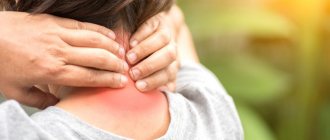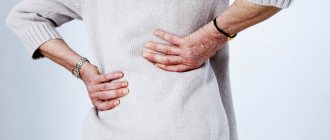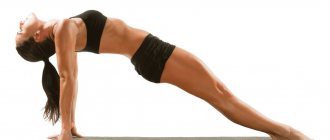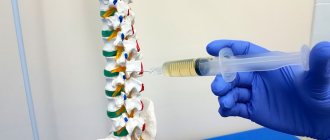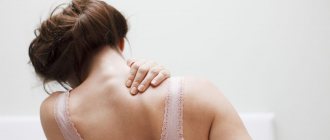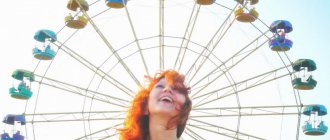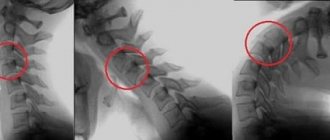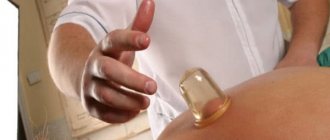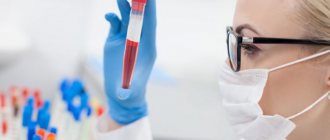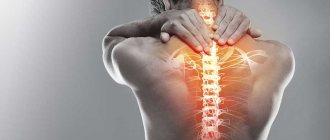Cervical osteochondrosis is increasingly being diagnosed in young people. The main reason is sedentary work at the computer or while driving. In this position, the intervertebral discs are constantly under strong static load and do not receive sufficient nutrition.
The muscular corset that supports the spine weakens significantly without sufficient physical activity.
It is quite possible to slow down the development of cervical osteochondrosis and significantly alleviate its course by using complex therapy methods, one of which is massage.
How does massage help with cervical osteochondrosis?
Massage of the cervical spine area, when performed regularly, can slow down the progression of osteochondrosis and avoid exacerbations. A competent massage has the following beneficial effects:
- spasms of the cervical muscles are relieved and the normal tone of weakened muscles is restored, the feeling of tension goes away;
- on the part of the lymphatic system, the outflow of lymph from the affected area is normalized;
- improves blood supply (especially capillary) to tissues in this area, the work of blood vessels responsible for feeding the intervertebral discs;
Professional massage is especially effective and recommended in the early stages of cervical osteochondrosis, when the symptoms of the disease are mainly associated with muscle spasms. Relieving spasm leads to partial or complete elimination of pressure on large vessels and the spinal nerve, and subsequently to the weakening or elimination of symptoms associated with impaired cerebral blood supply:
- headaches and dizziness;
- fainting due to sudden movements of the neck;
- tinnitus and hearing loss;
- sensation of spots before the eyes;
- swelling of the face in the morning;
- fatigue and redness of the eyes for no apparent reason.
An improved drainage of lymph helps to reduce the swelling that accompanies the inflammatory process and reduce pressure on the spinal roots, eliminating pain due to pinching.
In combination with physical therapy, massage can significantly delay the later stages of osteochondrosis.
Improving microcirculation in the intervertebral discs, and therefore their nutrition, slows down the process of their destruction. To get the maximum effect, massage must be combined with feasible physical exercise, walking. Men will additionally be able to strengthen their shoulders.
Features of therapeutic back massage for various diseases
Scoliosis
The cause of lateral curvature of the spine is unequal tension in the back muscles. If the side is convex, then they are relaxed, if the side is concave, they are overstrained.
The specialist’s task is to ultimately strengthen the first muscle group and relax the second. The technique of therapeutic back massage for scoliosis is quite complex. It must be done by a highly qualified specialist, because incorrect actions can only worsen the situation. It is worth noting that the presence of fourth degree scoliosis excludes the possibility of massage.
Osteochondrosis
Osteochondrosis is a disease of the spine that is accompanied by back pain. Depending on the affected area, osteochondrosis of the lumbosacral, cervical and thoracic regions is distinguished. Also, pathology can spread to several departments at once.
The therapeutic massage technique is standard: stroking, deep stroking, rubbing, kneading, stroking. In order to get maximum results, massage is often performed not only on the affected area, but also on the entire back. The minimum course duration is 10 sessions.
Radiculitis
Radiculitis is a lesion of the peripheral nervous system, which is accompanied by dull pain moving from the neck to the arm or from the lower back to the leg.
The course of massage is carried out during the absence of exacerbations. It can be aimed at treating a specific area or be general in nature. Massage that involves the arms and legs is most effective. At the beginning of the course, in the first two or three sessions, light pressure is applied, there are no sudden massage movements. The duration of the massage is 5–10 minutes. Next, the load gradually increases, and the duration of the therapeutic back massage increases to half an hour. A general massage lasts approximately one hour.
Recommended articles on the topic:
- Thermal detoxification: lightness of the body and clear skin
- Lipolytic therapy: indications, contraindications, stages of the procedure
- Weight correction: everything you need to know about the procedure
Sciatica and lumbago
Sciatica and lumbago are diseases that have different natures, but are similar in symptoms. They are characterized by the presence of pain in the lower back with continuation to the buttocks and legs.
Therapeutic back massage has shown good results in the fight against these pathologies. Its benefit is that it reduces the inflammatory process, accelerates blood circulation, improves muscle tone, relieves swelling and numbness. A reduction in pain after a therapeutic back massage occurs after two or three sessions, and complete relief from them is observed after completing the course. To record the results obtained and prevent it, it is recommended to do 15 sessions.
The procedure for performing a therapeutic back massage for sciatica and lumbago: stroking, patting and rubbing. The first sessions are lightweight in order to avoid pain and discomfort for the patient.
Intervertebral hernia
The cause of intervertebral hernia is degenerative changes in the intervertebral discs. This disease is treated comprehensively.
Back massage should be performed during the recovery stage. If there is pain, it is contraindicated because it can cause back spasms.
Therapeutic massage, the indications for which are intervertebral hernia, must be performed by a highly qualified specialist. Any violation of the technique can cause complications requiring surgical intervention. The massage technique is determined in each specific case individually. Only the tissues adjacent to the hernia are massaged.
If the massage is performed by a specialist who takes into account specific diseases and correctly prescribes treatment, patient reviews are always positive.
When treating the above pathologies, back pain regularly occurs after procedures. This is fine. In addition, there are several ways to deal with them.
Read material on the topic:
Manual therapy of the spine
Contraindications to massage for cervical osteochondrosis
Massage of the cervical-collar area should not be done if you have the following diseases or conditions:
- benign and malignant tumors;
- in the phase of exacerbation of osteochondrosis;
- intervertebral disc herniation;
- infections and non-infectious inflammations of the brain and spinal cord, the presence of hemorrhagic stroke;
- any problems with blood clotting;
- aneurysms of vessel walls;
- fever of any origin;
- thrombophlebitis;
- any infection in the acute stage;
- cardiac, renal, pulmonary, liver failure;
- purulent processes in any part of the body;
- skin rashes, ulcers, inflammations, skin irritations in the massage area.
Before starting massage procedures, it is necessary to conduct a full examination and consult a doctor.
The doctor should also look at the patient's medical history.
Types of massage for cervical osteochondrosis
In the complex treatment of osteochondrosis of the cervical spine, the following massage options are most often used:
Classic massage - this type of treatment is recognized by modern medicine as one of the methods of treating this disease, and is the most common and effective.
Vacuum massage is also called cupping and is performed using a special plastic jar, which is suctioned to oiled skin. Vacuum action improves tissue metabolism and blood circulation, but does not greatly affect muscle tone.
A similar effect is possible with a special massager that regulates the level of pressure inside the jar.
Acupressure or acupressure massage of the cervical-collar area involves pressing on certain points to relieve muscle spasm. However, this Chinese massage technique, like the Japanese one, is not recognized by modern official medicine as an effective treatment for osteochondrosis. Although, judging by the reviews, it has the best effect.
The effectiveness of manual therapy
Often, a neck massage is the only way to get rid of constant debilitating pain and tense muscles.
A correctly carried out procedure helps achieve several goals:
- relieve muscle spasm in the collar area, neck, thoracic spine;
- reduce the amount of lactic acid accumulating in the muscles;
- increase the tone and resistance to stress of the neck muscles;
- stimulate blood circulation in the area of inflammation;
- reduce or completely eliminate pain in the cervical spine and collar area.
Thanks to deep muscle work, blood supply to tissues and oxygen supply improves, the muscle frame is strengthened, and mobility is restored. In addition, headaches and a feeling of heaviness in the back of the head go away, overall health improves, and immunity increases.
Classic cervical spine massage technique
For cervical osteochondrosis, a massage of the cervical-collar area is performed, that is, the following is treated:
- back of the neck;
- shoulder girdle;
- deltoid muscles;
- anterior part of the sternum to the second rib.
Any massage movements should not cause pain or other discomfort.
Before starting the massage procedure, the patient should be placed on the couch on his stomach or seated at a table, chin tucked to the chest, hands on the table, forehead on the hands, shoulder girdle open. The patient must completely relax the muscles.
Classic massage is based on mechanical impact on the area being worked with the fingers and palms of the hands.
Therapeutic classic massage: technique
Stroking. This technique relieves swelling and eliminates pain from the cervical spine. Perform grasping strokes along the course of the lymph to the supraclavicular and axillary lymph nodes. The hand must be pressed tightly, but so that the skin does not move during manipulation. Use your fingertips to slowly glide over the skin.
Squeezing. This technique improves tissue nutrition and regeneration, increases muscle tone, and also eliminates wrinkles in the décolleté area. The palm slides and slightly presses on the skin, the tubercle of the thumb and the edge of the palm are involved. Movements are carried out from top to bottom to the shoulder joints from the fourth thoracic vertebra, as well as to the trapezius muscle down along the spinal column.
Trituration. The intake improves tissue nutrition, has the most positive cosmetic effect for women, and increases muscle contractility. Rubbing is performed with the pads of the fingers bent at the phalanges. The movement starts from the base of the skull, use your fingertips to rub in a straight line and in a circular manner, displacing the skin. The movements are faster and more intense than when stroking, the skin under the hand moves.
Kneading. Reception relieves muscle spasms, increases muscle elasticity, and enhances lymph and blood flow. On the neck along the paravertebral zones, perform longitudinal kneading in a circular motion. When kneading, grab and pull the area of soft tissue, then without jerking or quickly squeeze and roll the muscles with your thumb and forefinger.
Vibration improves tissue regeneration. The technique involves tapping the skin with your fingers, the edge or heel of your palm, flat or cupped into a fist. The blows are performed energetically, but softly. One area is normally massaged for no more than 10 seconds.
You can massage the cervical-collar area yourself at home; it is useful to do this daily to relieve tension.
Massage technique
With torticollis, the patient is placed on his healthy side. After kneading the muscles, which helps warm up the tissues, the massage therapist strokes and rubs the part of the back and collar area adjacent to the neck. The direction of movement is from the collarbone to the head. The affected muscle is treated as gently as possible, without sharp or intense pats. Optimally targeted treatment promotes faster relaxation and pain relief.
A special oil is used to glide the palms over the skin, which has a slight warming effect. As a rule, a session lasts 20-30 minutes – this is enough to effectively stretch the muscles without aggravating the patient’s condition. Massage movements rarely cause pain; if the effect causes discomfort, a more gentle method of treatment is selected.
After the procedure, it is necessary to cover the treated area and protect it from hypothermia. There are practically no side effects after it, but the first sessions may cause slight weakness and drowsiness. They go away within a few hours, after 2-3 sessions the patient feels only lightness and a surge of strength. In rare cases, side effects may include: vertebral hypermobility, dizziness, nausea.
Acupressure of the cervical region
This type of massage affects acupuncture points. If you apply this Chinese technique correctly, pain disappears, tension and muscle spasm are relieved. Acupressure treatment has a relaxing effect on them, releasing pinched nerve endings.
The patient usually feels relief at the very beginning of the course of procedures. Blood supply to the cervical spine improves, various seals dissolve faster.
Acupressure for cervical osteochondrosis should be performed exclusively as prescribed by a doctor in order to relieve tension and pain.
Execution technique
Sequence of actions when performing a massage:
- Feng fu point. Acupressure begins with the area under the occipital protuberance. Screwing movements are performed clockwise for 1 minute. After a delay of a few seconds, switch to loosening movements counterclockwise.
- Feng chi point. The point between the sternocleidomastoid muscle and the occipital bone should be impacted for 3-4 minutes with medium force. This will lead to relief of pain and relaxation of the neck muscles.
- Chuntu point. Find a point on the line between the 6th and 7th vertebrae on your back, press it with the pad of your finger for 5 minutes. This will improve venous and lymphatic drainage from the paravertebral tissues and reduce swelling.
- Point da-zhui. This is the 7th cervical vertebra. The impact on this point has a relaxing effect and is the best end to an acupressure session.
To improve the patient’s well-being and increase the effectiveness of treatment, acupressure is best performed after classical massage. For this, several points are usually selected.
Impact points
Before moving on to examining the points themselves, it is necessary to understand the methods of influencing them . The most common are:
- Finger pressure - uses the thumb, index and middle fingers.
- Nail prick - use the nail plate of the thumb and index finger.
- Warm-up and local massage are carried out using the thumb and elbow joint.
- Recognition - the finger is pressed with maximum force, as if piercing it into soft tissue.
Expert opinionIgor Valentinovich AstafievNeurologist - Pokrovsk City Hospital. Education: Volgograd State Medical University, Volgograd. Kabardino-Balkarian State University named after. HM. Berbekova, Nalchik. In the practice of acupressure, more than 45 points , located throughout the body and capable of influencing the course of cervical osteochondrosis.
Let's consider only the most popular and effective of them.
Ya-Men (“gate of silence”) – is located in the area of the second cervical vertebra (between the first and second, closer to the second). Pressure is applied to this point, alternating with relaxation. By stimulating blood flow to this area, headaches disappear, head mobility improves, and neck swelling decreases.
Feng Fu (“eternal youth”) – located 2 cm below the occipital protrusion in a depression.
Massage and active pressure help launch the body's regeneration processes, which strengthens the immune system and helps normalize the nutrition of cartilage. This point helps to relax the neck muscles, which are in constant tone with osteochondrosis. Helps relieve acute pain. Before starting the massage, some chiropractors apply a piece of ice to the area for 30-50 seconds. Chun-Gu (“no pain”) – located between the 5th and 6th vertebrae of the neck. Massaging pressure stimulates the outflow of venous blood, reducing swelling and pain of soft tissues.
Intense pressure can stimulate the functioning of brain cells, which improves memory, normalizes blood pressure and promotes good sleep.
Feng Chi - located in the back of the head, at the junction between the edge of the occipital bone and the sternocleidomastoid muscle. Intense pressure stimulates relaxation of the lateral muscles of the neck, which causes a decrease in pain and an increase in the range of head movements when bending to the sides. Da-Zhui - stimulation of this point leads to the release of Qi energy, as well as blood flow.
Responsible for rejuvenating the body, and also reduces pain localized in the spinous processes. The point is located at the level of the collarbone in the region of the spinous process of the 6-7-8 vertebra. Article on the topic: All about massage for osteochondrosis of the lumbar spine
Nao-Hu - located in the back of the head.
Stimulates blood flow to the head and also eliminates the symptoms of migraine-like headaches. The point is stimulated with two fingers, and a pulsation is felt in the temples. Tian-Yu is a paired point located on the side of the neck at the level of the mandibular bone. Massaging movements and pressing of this point help to increase the conduction of nerve impulses from the brain to the neck.
Acupressure helps relieve acute pain in the head and also improve neck mobility.
Hsin-Shi is one of the key points in the treatment of neck osteochondrosis. A lot of techniques are used to stimulate this point.
To achieve maximum effect, several points can be stimulated . With such combinations, blood flow to the cartilage tissue is faster, and regeneration is accordingly accelerated.
It has been scientifically proven that massage of points in the neck can have positive dynamics in the treatment of cervical osteochondrosis. However, massage can never compete with drug therapy. It should not be perceived as a panacea, but as a segment of complex therapy.
This is the only way to achieve the best results by stopping and slowing down the destruction of cartilage.
We strongly recommend watching a useful video on this topic.
